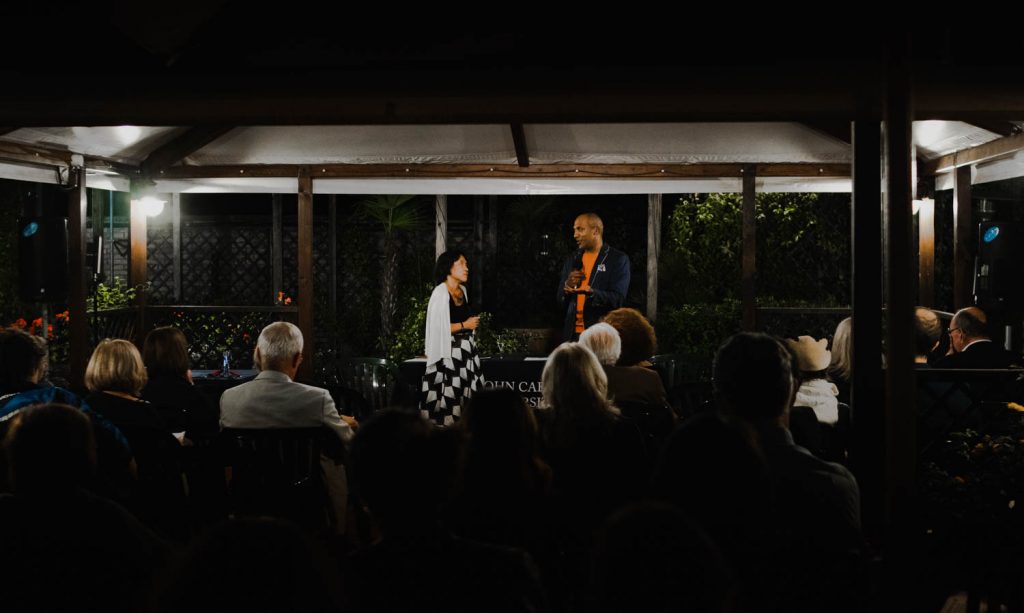Using Social Media for Good: JCU Welcomes Sree Sreenivasan, America's Tech Guru
Almost everyone will miss almost everything you do on social media. Until you make a MISTAKE. (Sree Sreenivasan)
Number two on Sree Sreenivasan’s Top Social Media Tips, the tip in question is perhaps the most relevant today. Where many seem to be falling on their own social media swords, rumor makes social media out to be the villain; but is it really?
On October 18, 2018, the John Cabot University community had the opportunity to listen to the advice of Sree Sreenivasan, the man who has been called “America’s Tech Guru.”
The conversation-based event, entitled “Using Social Media for Good,” was led by JCU Visiting Professor Deanna Lee, and was centered on understanding the importance of social media today. The talk, part of the Office of the Dean of Academic Affairs Lecture Series, was streamed live on JCU’s Instagram profile and on Sree’s Facebook account.
A former Chief Digital Officer of Columbia University, The Metropolitan Museum of Art, and the Mayor’s Office of the City of New York, Sreenivasan is an authority on all things digital. In 2015, he was included in Fast Company magazine’s list of the Most Creative People of the year, after having previously been listed in Poynter Institute’s 35 most influential people on social media.
JCU Visiting Professor of Communications Deanna Lee was the recipient of eight news and documentary Emmy Awards before adapting her career in journalism to communications and digital strategies—first for the Asia Society, then The New York Public Library, and Carnegie Corporation of New York.
USING SOCIAL MEDIA FOR GOOD
Co-founder of the Digimentors, consultancy group, Sreenivasan shared useful tips that he gives to clients all over the world, especially on how organizations and individuals can use social media for important causes. He gave an example of how he used social media for good in 2016 by posting on Facebook a pledge that he had made to his daughter: he would refuse to attend any all-male panels he was invited to. The idea grew quickly, and soon attracted supporters from all over the world. From this idea, the app “Gender Avenger” was created, a service that allows users to tally the minutes male and female panelists are allotted.
SOCIAL MEDIA AT THE METROPOLITAN MUSEUM
During his time at the MET, Sreenivasan was pivotal in leading the museum into the social media age. He explained that accessibility is key when it comes to an organization’s online presence. In the MET’s case, Sreenivasan created the #emptyMet tour, where guests were given the opportunity to visit an “empty” museum. Sreenivasan explained that the goal was to open up the museum not only to experts but to everyone. Along with the tour, Sreenivasan also created a hashtag for every exhibit, thus furthering accessibility.
As Sreenivasan recounted his time at the MET, he went on to explain the importance of being a “tradigital” user, a term coined by his friend Sig Gissler. The tradigital user, Sreenivasan explained, is a traditional journalist with a digital overlay. He also distinguished between the digital skill set and the digital mindset. The difference is that the former can be acquired, whereas the latter is innate. Nevertheless, Sreenivasan said that storytelling is still the central mechanism to understanding, and using social media correctly; the secret is in the technological overlay one applies to it.
QUESTIONS FROM THE AUDIENCE
How can I detect fake news? “My policy has been if you read something on the internet that seems too good to be true, or too bad to be true, it probably is…not true,” says Sreenivasan. With this premise, Sreenivasan went on to explain how Wikipedia is an example of how a community can come together and help edit the fake out of the news. “Anyone can edit Wikipedia, which some people think makes it terrible, and it isn’t perfect, but in the last two years it’s the platform that came out smelling the best after all these fake news crises.”
What is your impression of the way our children are using social media platforms?
“Unlike us, the digital immigrants, our children, digital natives, are used to having everything in the palm of their hand. They are exposed to so much content, so it’s understandable to be concerned. One way our household has chosen to face the issue is by adopting the ‘device-free meal’ rule. By limiting the use of technology when we’re together, we are able to connect in real time.”
Another way to limit the use of devices according to Sreenivasan is to use the “grayscale” feature on phones since it’s the colors that attract us to different apps and distract us.
We are a small organization with limited resources and bandwidth. What metrics beyond engagement and followers should we utilize to measure and assess our impact?
“The thing to do is to think about social media as being distributed across the organization. To get everybody in the organization involved, instead of relying on the social media team that runs the risk of burning out.”
During his time at the MET, Sreenivasan, in fact, spread social media duties across the 2400 MET employees. Interestingly, the best Instagrammer turned out to be one of the 700 security guards. Thanks to her good eye, some social media training, early shifts, and unusual angles, the guard, who had worked at the MET for 30 years, turned out to be a great addition to the MET’s social media team.
Sreenivasan also explained how, in terms of assessment, it is important to have followers, but stressed the fact that quality followers are even more important. He then advised that “you shouldn’t let the cool kids bully you into telling you what platforms you should be on.” In other words, the organization should understand where most of their audience is, and engage with them on the platform that suits them best.
In conclusion, Sreenivasan reminded everyone that social media can be used for great things, but nevertheless, it requires mindfulness on the part of the user. “I take this so seriously that I spend 6 to 10 minutes on every tweet I write, and every Instagram and Facebook post…because it can be out there in perpetuity,” explains Sreenivasan. Finally, “Tweet as if your next tweet were your last,” advises Sreenivasan.
Watch Sree Sreenivasan’s entire talk.
See Sreenivasan’s in one page.







